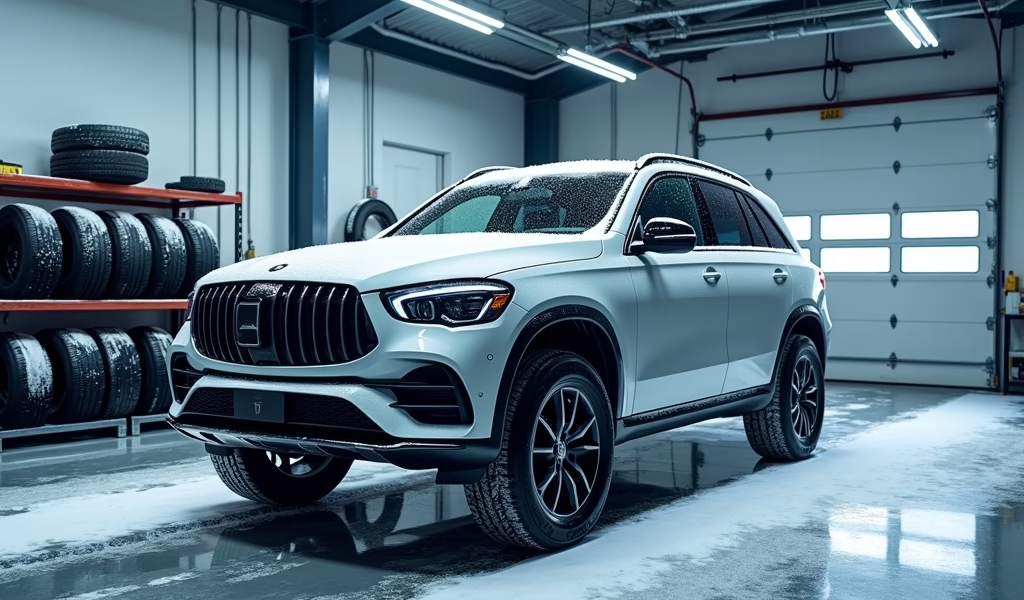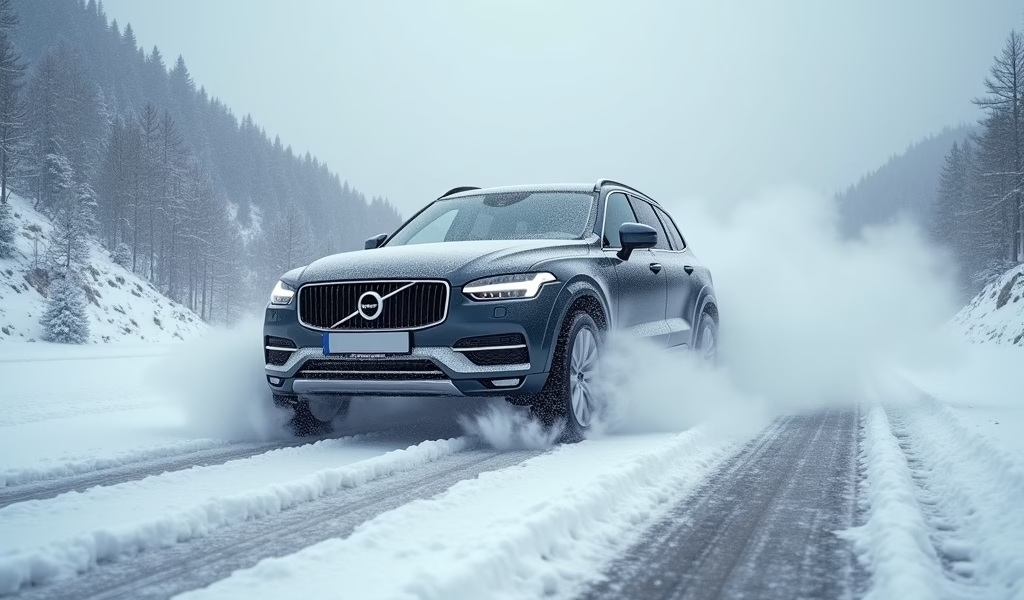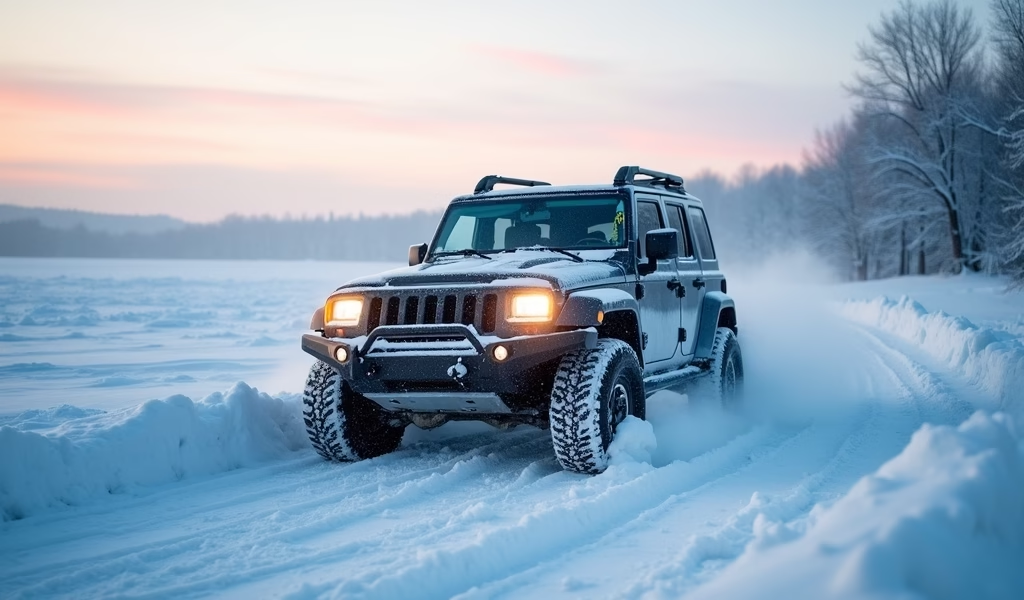Overview
This article outlines the key elements that make vehicles snow-worthy, highlighting specific models like the Subaru Outback and Jeep Grand Cherokee while emphasizing that winter tires are more critical than AWD systems alone. Beyond vehicle selection, the guide covers essential winter maintenance including battery care, fluid management, proper snow removal techniques, and emergency preparedness to ensure safe winter driving.
Table of Contents
- Introduction: Navigating Winter Roads With Confidence
- What Makes a Car Snow-Worthy?
- Top Vehicles for Snow Performance
- Winter Tire Essentials: Your First Line of Defense
- Battery Care in Cold Weather
- Fluid Management: Winter’s Hidden Challenge
- Snow Removal and Protection
- Winter Emergency Kit: Be Prepared
- Conclusion
- Frequently Asked Questions
Introduction: Navigating Winter Roads With Confidence
Winter driving presents unique challenges that can test both driver and vehicle. When snow blankets the roads, having the right car with proper preparation makes all the difference between a stressful commute and a confident journey.
As a master mechanic with 20+ years of experience in cold-weather regions, I’ve seen firsthand how the right vehicle combined with proper maintenance creates a formidable defense against winter’s worst conditions. The best cars for snow aren’t just about all-wheel drive—they integrate specific design elements and technologies that work together to conquer slippery surfaces.
In this comprehensive guide, we’ll explore vehicle features that truly matter in snow performance and share five essential care tips that will keep you safely moving when winter throws its worst your way. Whether you’re shopping for a new vehicle or preparing your current ride, these insights will help you navigate winter with confidence.
What Makes a Car Snow-Worthy?
Not all vehicles perform equally when the snow flies. Several key factors determine how well a vehicle handles winter conditions, and understanding these elements helps you make informed choices.
Drive Systems: The Foundation of Snow Performance
The drivetrain forms the backbone of a vehicle’s winter capability:
- All-Wheel Drive (AWD): Provides power to all four wheels automatically, offering excellent traction in variable conditions. Modern AWD systems can instantly redirect power to wheels with grip, making them ideal for unpredictable winter roads.
- Four-Wheel Drive (4WD): Traditionally found in trucks and SUVs, 4WD systems deliver robust performance in deep snow but may lack the sophistication of newer AWD systems for mixed conditions.
- Front-Wheel Drive (FWD): Places the engine weight over the drive wheels, providing decent snow performance with proper tires. FWD vehicles typically outperform rear-wheel drive in snow.
- Rear-Wheel Drive (RWD): Generally the least snow-capable configuration, though modern traction control systems have improved their winter performance.
Critical Snow Performance Features
Beyond the drivetrain, several design elements contribute to snow capability:
- Ground Clearance: Higher ride height prevents bottoming out in deep snow. Look for at least 8 inches of clearance for serious winter conditions.
- Electronic Stability Control: This technology helps prevent skids by applying brake pressure to individual wheels—crucial on slippery surfaces.
- Weight Distribution: Balanced vehicles provide more consistent traction across all wheels, improving handling in slippery conditions.
- Limited-Slip Differentials: These mechanical systems transfer power to the wheel with better traction, preventing the common problem of a spinning wheel while its partner sits motionless.
While AWD provides a significant advantage, I’ve seen properly equipped front-wheel drive cars with winter-specific tire compounds outperform AWD vehicles with all-season tires. The complete package matters more than any single feature.

Top Vehicles for Snow Performance
After years of winter service calls and personally testing countless vehicles in snow conditions, these models consistently demonstrate exceptional winter performance:
SUVs and Crossovers
- Subaru Outback: Combines 8.7 inches of ground clearance with one of the most sophisticated AWD systems available. Its boxer engine layout creates a lower center of gravity for improved stability.
- Jeep Grand Cherokee: Offers selectable terrain modes specifically designed for snow conditions. The Quadra-Drive II system can transfer 100% of power to a single wheel if needed.
- Toyota RAV4 Hybrid: Provides excellent fuel efficiency with capable AWD performance. The electric motor powers the rear wheels, eliminating the need for a traditional driveshaft.
- Volvo XC90: Swedish engineering shines with advanced stability control and exceptional weight distribution. The intelligent AWD system predicts slippage before it occurs.
Sedans and Wagons
- Subaru Legacy: Offers the same symmetrical AWD system as the Outback in a lower-profile sedan package.
- Audi A4 Allroad: Features the legendary quattro AWD system with a slight ground clearance increase over the standard A4.
- Volvo V90 Cross Country: Combines wagon practicality with raised suspension and advanced traction management.
Budget-Friendly Options
- Mazda CX-5: Offers predictive AWD that monitors temperature and wiper usage to anticipate snow conditions.
- Subaru Impreza: The most affordable AWD vehicle on the market with standard stability control.
- Honda CR-V: Provides reliable winter performance with a well-tuned AWD system that reacts quickly to traction loss.
According to NHTSA safety data, vehicles with electronic stability control (now standard on all new vehicles) reduce crash risk by 32% on slippery surfaces. When combined with AWD and proper tires, these technologies create a comprehensive winter safety system.
Winter Tire Essentials: Your First Line of Defense
Even the best snow vehicle will struggle without proper winter tires. I’ve rescued countless AWD vehicles stuck in snow—all wearing inappropriate tires. The right tires transform winter driving more than any other single factor.
Why Winter Tires Matter
Winter tires differ from all-season options in three crucial ways:
- Rubber Compound: Winter tires use specialized rubber that remains flexible in freezing temperatures, while all-season compounds stiffen and lose grip below 45°F.
- Tread Design: Aggressive patterns with deeper sipes (tiny slits) create biting edges that grip snow and ice.
- Snow Channels: Wider grooves between tread blocks channel snow away from the contact patch, preventing compaction and maintaining grip.
Tests consistently show that a front-wheel drive vehicle with winter tires outperforms an AWD vehicle with all-season tires in braking, cornering, and acceleration on snow and ice. This isn’t marketing hype—it’s physics.
Winter Tire Pressure Management
Cold temperatures significantly impact tire pressure. For every 10°F drop in temperature, tire pressure decreases by approximately 1 PSI. This invisible deflation compromises handling, traction, and fuel efficiency.
Check your tire pressure weekly during winter using a quality gauge, preferably when tires are cold. The correct pressure specification is typically found on a sticker inside your driver’s door jamb—not the maximum pressure listed on the tire sidewall.
Don’t reduce tire pressure in winter to gain traction. This outdated practice increases the risk of tire damage and actually reduces overall grip by deforming the tire’s contact patch.
For extreme conditions, consider whether studded tires fit your regulations and needs. While providing superior ice traction, they create more road noise and may be restricted in certain regions.
Rotation and Tread Depth
Winter driving accelerates uneven tire wear, particularly on AWD vehicles. Maintain a regular rotation schedule (every 5,000 miles) to ensure even wear across all tires.
Monitor tread depth vigilantly. Winter tires begin with approximately 10/32″ to 13/32″ of tread depth. Once they wear below 6/32″, their winter performance degrades significantly. Use the “quarter test” by inserting a quarter with Washington’s head upside down into the tread—if you can see the top of his head, it’s time to replace your winter tires.
Battery Care in Cold Weather
Cold weather is ruthless on vehicle batteries. At 32°F, a battery loses approximately 35% of its starting power. At 0°F, that loss increases to around 60%. This explains why a battery that performed perfectly in fall might leave you stranded on the first truly cold morning.
Preventative Battery Maintenance
Implement these practices to keep your battery healthy through winter:
- Load Testing: Have your battery professionally load-tested before winter arrives. This stress test identifies weakening batteries before they fail.
- Clean Connections: Corrosion on battery terminals creates resistance that reduces charging efficiency and starting power. Clean terminals with a wire brush and apply terminal protectant.
- Parasitic Draw Check: Electrical problems that drain batteries become critical in winter. Have a professional check for unusual power draws if your battery frequently discharges.
- Driving Habits: Short trips don’t allow batteries to fully recharge. Try to include at least one 20-minute drive weekly to maintain proper charge.
Modern vehicles with advanced electronics and start-stop systems place even greater demands on batteries. Consider upgrading to an AGM (Absorbed Glass Mat) battery if you frequently encounter cold starts below 0°F.
Jump-Starting Safely
Even well-maintained batteries sometimes surrender to extreme cold. If you need a jump-start, follow this sequence to avoid damaging sensitive electronics:
- Position vehicles close but not touching, with both engines off and parking brakes set.
- Connect the positive (red) cable to the dead battery’s positive terminal.
- Connect the other end of the positive cable to the good battery’s positive terminal.
- Connect the negative (black) cable to the good battery’s negative terminal.
- Connect the other end of the negative cable to an unpainted metal surface on the dead car’s engine, NOT the battery terminal.
- Start the good vehicle and let it run for 2-3 minutes.
- Attempt to start the dead vehicle (limit cranking to 10-second attempts).
- Once started, remove cables in reverse order.
Portable jump starters have evolved dramatically in recent years. Modern lithium jump packs are compact enough to store in your glove box yet powerful enough to start V8 engines in sub-zero temperatures. They’re worth the investment for winter peace of mind.

Fluid Management: Winter’s Hidden Challenge
Vehicle fluids face unique challenges during winter. Proper maintenance of these vital liquids ensures reliable performance when temperatures plummet.
Winter-Grade Oil: The Lifeblood
Cold temperatures dramatically increase oil viscosity. Thick, sluggish oil struggles to circulate during cold starts, leaving critical engine components temporarily unprotected.
Winter-grade oils (typically 5W-30, 0W-20, or 0W-30) flow more readily at low temperatures. The first number indicates cold-flow properties—lower numbers provide better cold protection. Check your owner’s manual for manufacturer recommendations, as using oil that’s too thin can reduce protection once the engine reaches operating temperature.
Synthetic oils generally offer superior cold-flow properties compared to conventional oils. While more expensive initially, they often enable extended drain intervals and provide better protection across temperature extremes.
Antifreeze: Beyond Freeze Protection
Your cooling system needs proper antifreeze concentration to prevent freezing and potential engine block damage. The ideal mixture (typically 50/50 antifreeze and water) protects against freezing while maintaining efficient heat transfer.
Test your antifreeze with an inexpensive tester to verify freeze protection. If protection is inadequate, have the system flushed and refilled rather than simply adding concentrated antifreeze, which can create imbalanced protection.
The chemical inhibitors in antifreeze also prevent internal corrosion. These additives deplete over time, which is why coolant should be replaced according to your manufacturer’s schedule (typically every 30,000-50,000 miles) even if freeze protection remains adequate.
Winter Windshield Washer Fluid
Standard summer washer fluid freezes at 32°F, potentially damaging reservoirs and lines. Winter-specific formulations resist freezing to -20°F or below while effectively cutting through road salt residue that impairs visibility.
During winter, consumption increases dramatically. Keep your reservoir filled and carry a spare gallon during extended trips. Consider upgrading to heated washer fluid systems for extreme conditions—they use engine coolant heat to prevent fluid freezing and improve ice removal.
Understanding the science of hydroplaning speed factors also applies to winter driving, as slush creates similar traction challenges to standing water.
Snow Removal and Protection
Proper snow removal is about more than convenience—it’s essential for safety and vehicle longevity. The salt and chemicals used for road treatment accelerate corrosion, making protection crucial.
The Complete Snow Removal Process
Follow this sequence for efficient, damage-free snow removal:
- Start your vehicle and set defrosters to maximum before beginning exterior clearing.
- Remove snow from the roof first, working from the center outward to prevent scratching paint.
- Clear all windows completely—not just a peephole in the windshield.
- Remove snow from headlights, taillights, and side mirrors.
- Clear license plates to avoid unnecessary violations.
- Clean snow from around exhaust pipes to prevent carbon monoxide from entering the vehicle.
Avoid using metal scrapers or shovels that can damage paint and trim. Foam brushes with extendable handles allow you to reach across roofs without stretching or leaning against dirty panels.
Preventing Salt Damage
Road salt creates a highly corrosive environment that accelerates rust formation. Implement these protective measures:
- Apply a quality wax before winter begins to create a protective barrier.
- Wash your vehicle regularly during winter when temperatures permit (above freezing).
- Pay special attention to wheel wells, underbody areas, and lower door panels where salt concentration is highest.
- Consider an annual undercoating service for vehicles in heavy salt regions.
- Immediately wash off salt residue after major storms or extended highway driving.
Research from Consumer Reports indicates that regular winter washing can significantly extend a vehicle’s usable life in salt-belt regions.
Winter Emergency Kit: Be Prepared
Even the best-prepared vehicles can face unexpected challenges during severe winter conditions. A properly stocked emergency kit provides peace of mind and potentially life-saving resources.
Essential Winter Emergency Items
- Folding shovel: Compact military-style entrenching tools work well for digging out from snowdrifts.
- Traction aids: Foldable traction mats or bags of cat litter provide grip when stuck.
- Jumper cables or portable jump starter: Battery failures peak during cold snaps.
- LED flashlight with extra batteries: Winter brings extended darkness and earlier sunsets.
- Thermal blanket: Provides warmth if stranded with a disabled heater.
- Hand warmers: Chemical packs activate when needed and stay warm for hours.
- Non-perishable snacks and water: Energy bars and sealed water provide sustenance during extended delays.
- First-aid kit: For treating minor injuries while waiting for assistance.
- Portable phone charger: Maintain communication with emergency services.
Store these items in a waterproof container secured in your trunk or cargo area where they won’t become projectiles in an accident.
Winter Driving Techniques
The best equipment still requires proper driving techniques to maximize safety:
- Gentle inputs: Smooth, progressive acceleration, braking, and steering prevent traction loss.
- Extended following distance: Triple normal distances on snow, quadruple on ice.
- Momentum management: Maintain gentle momentum when approaching hills—neither too fast nor too slow.
- Brake before turns: Reduce speed before entering curves, then maintain steady throttle through them.
- Skid recovery: Look and steer where you want to go, avoid overcorrection.
Even with AWD and winter tires, physics still applies. Reduce speed appropriately for conditions and leave extra time for winter journeys.
Conclusion
The best cars for snow combine thoughtful engineering with proper maintenance and preparation. While AWD SUVs like the Subaru Outback and Jeep Grand Cherokee excel in winter conditions, even front-wheel drive vehicles can perform admirably with quality winter tires and careful driving.
Remember that winter preparedness isn’t a single action but an ongoing process. Regular maintenance checks, appropriate tire management, and keeping fluids at optimal levels all contribute to reliable winter performance.
The five care tips we’ve covered—winter tire maintenance, battery care, fluid management, proper snow removal, and emergency preparedness—form a comprehensive strategy that will keep you moving safely when winter throws its worst your way.
With the right vehicle, proper preparation, and responsible driving techniques, winter roads become manageable challenges rather than stress-inducing hazards. Stay safe, stay prepared, and enjoy the unique beauty that winter driving can offer.
Frequently Asked Questions
Is AWD or 4WD better for snow driving?
AWD is generally better for everyday winter driving as it automatically adjusts power distribution and works continuously. 4WD provides stronger performance in deep snow but requires manual engagement and may be less refined on mixed surfaces.
Can I use all-season tires instead of winter tires?
All-season tires are a compromise that perform adequately in light snow but significantly underperform winter tires in true winter conditions. The rubber compounds in all-season tires harden below 45°F, reducing traction when you need it most.
What’s the most important feature for snow driving?
Quality winter tires are the single most important feature for snow driving, outweighing the benefits of AWD alone. The combination of winter tires and AWD provides the best overall winter performance.
How often should I wash my car in winter?
Wash your vehicle every 7-10 days during winter if possible, especially after major storms or highway driving. Focus on underbody washing to remove corrosive salt deposits that accelerate rust formation.
Should I warm up my car before driving in winter?
Modern vehicles need minimal warm-up—about 30 seconds to circulate oil before driving gently. Extensive idling wastes fuel and increases emissions while actually extending the time needed for the engine to reach optimal operating temperature.

